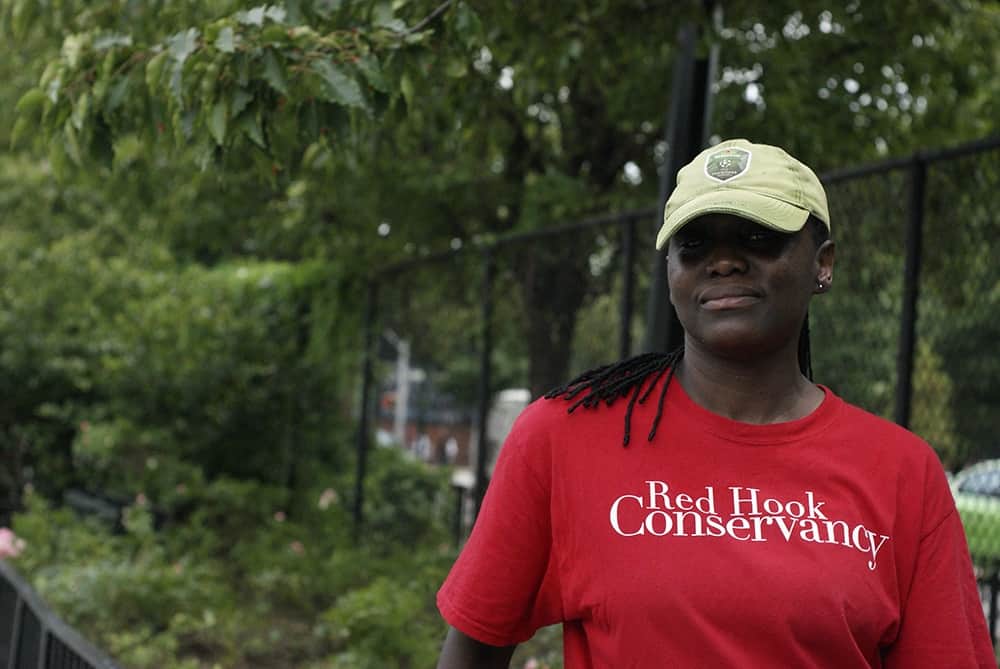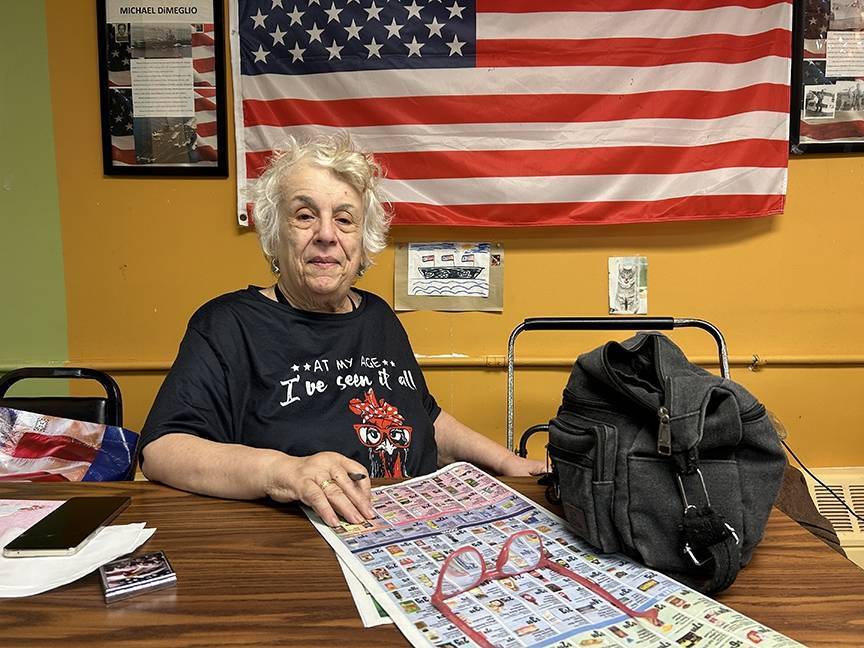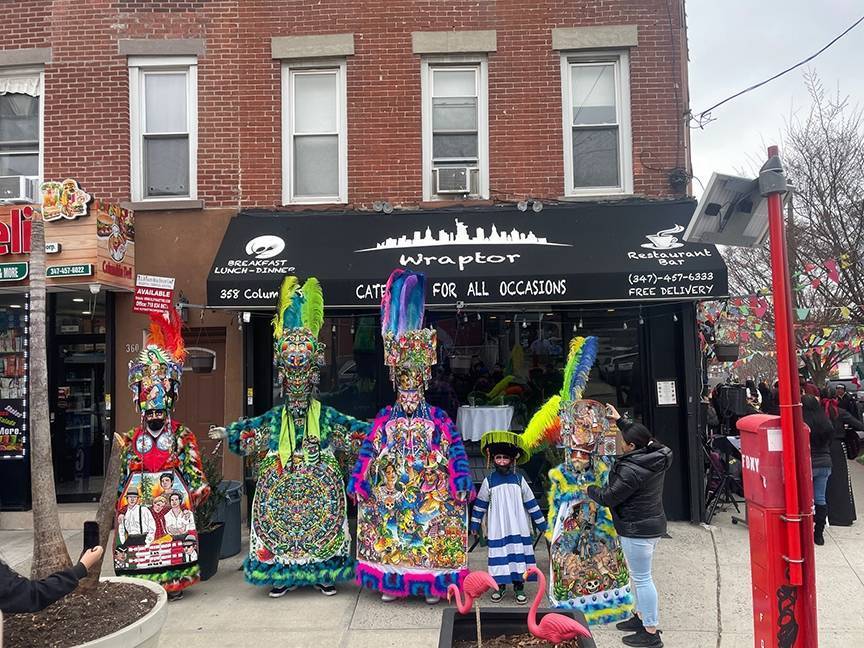
On a particularly hot Saturday in July, braving the 95 degree heat, Marlene Pantin walks up to a group of volunteers with a smile on her face and a cooler of water in hand.
It’s a scene you could expect to find most Saturdays during the warmer months of the year.
As she enters the scene, Marlene’s volunteers weed a patch of garden that lines the edge of Bush-Clinton Park, or T Park, as it is referred to by many locals. Other days you might see a similar group planting bulbs or watering flowers — anything to improve Red Hook’s parks.
Marlene’s words are encouraging and instructive as she gets a sense of the progress of the 10 or so volunteers before her. She draws attention to their successes and points out the work that’s still to be done — vines still need to be cut away from the bushes and pulled out from among the roses.
“That’s amazing!” Marlene exclaims, encouraging the workers who by now have sweat dripping down their faces. She adds, “Now we can see the roses.”
Her words are met with smiles all around.
Marlene is the president and founder of the Red Hook Conservancy (RHC), formerly known as Friends of Red Hook Recreation Center, an organization that “engages in stewardship of Red Hook park spaces and advocacy for the Red Hook Recreation Center (RHRC).” Essentially, the organization helps with the upkeep of 15 parks in Red Hook, Admiral Park just on the other side of the BQE, and the Red Hook Recreation Center.
The organization’s work varies widely depending on the present needs. From making sure fitness equipment is serviced to fighting the constant battle against weeds and trash that threaten park spaces, Marlene is constantly kept on her feet, volunteering about 40-60 hours of her time each week, often late into the night and over the weekend. Why? She’s just that sort of person.
RED HOOK CONSERVANCY
“I didn’t plan to get into this line of work,” Marlene grins.
She moved to Carroll Gardens back when she was a teenager. “I used to come to Red Hook to hang out with people,” she recollects, briefly touching on the changes in the neighborhood over time.
But Marlene seems determined not to dwell on the past. It is not surprising, seeing as she has so little time to spare between emails and volunteer efforts, battles with the city, and pushes for the involvement of local politicians.
This all started six years ago, when Marlene became a member with the RHRC and noticed a problem.
Every day, the women at the gym were only allowed in the weight room for a few hours. During the remaining hours, the space was closed off to the ladies as a men’s locker room. The people at the front desk explained to her that they needed screens to block off the men’s locker space, but despite frequent requests, no screen had been provided.
Marlene didn’t take this sitting down. She quickly set into action and wrote a letter to Adrian Benepe, the NYC Commissioner of Parks at the time, that detailed the request and admonished the neglect as an act of gender bias against the women using the gym.
Benepe soon responded and, she recalls, “[the screens] came a few weeks later.”
In light of this success, RHRC called on Marlene to help with another problem — getting the Parks Department to maintain the gym equipment. She was more than willing, and before long, requests came flooding in.
What began as an individual act of service soon morphed into the Red Hook Conservancy.
Today, the organization has six core members and depends on hundreds of additional volunteers each year to keep the parks in decent shape. However, RHC always needs more hands.
“[Current involvement is] better than nothing, but never sufficient,” Marlene says. “We need more people from Red Hook.”
She looks out at her garden volunteers and explains that most people involved with RHC are not from the neighborhood. “Most of these people are from New York Cares,” she points out, referring to an organization that connects New Yorkers to volunteer opportunities throughout the city.
People in the neighborhood sometimes complain about the state of Red Hook’s parks, but to these people, Marlene has a lot to say.
“Other parks get private funds. Parks need a lot of money and the city doesn’t put much in,” she notes. “The thing is, you have to get involved. [Other parks] didn’t get started and that was it. People came in and volunteered.”
Marlene is always looking for new ways to get people and businesses involved with their local parks.
She has tried to secure as many grants as she can and puts in effort to increase the involvement of local businesses through programs like “Adopt a Tree,” which currently helps fund the maintenance of trees along Van Brunt Street.
In a push to get community input, RHC is now going through a process they call “Visioning.” By holding surveys and games for children, the organization hopes to gain insight from the community into ways the parks can be improved for local residents. They are planning meetings and hoping to get the people to come out and offer feedback.
WILDFLOWER GARDEN
Behind a small garden nestled between Bush-Clinton Park and the Red Hook Houses, there are poles sticking out of the ground where a fence used to be. Just beyond that perimeter, there are bright green and blue dumpsters lined up in a row. Cardboard boxes sit in a huge pile just off to the side. The little garden feels dwarfed by surrounding threats.
Marlene points it all out, noting the particulars of her struggle with NYC Housing Authority (NYCHA) to keep the area clean and prevent dump trucks from destroying the fence. Everything, it seems, is a battle.
Turning toward the wildflower garden, Marlene draws attention to the flourishing rosemary and fennel plants RHC added in among the flowers to keep the caterpillars off the blooms. She smiles widely as she describes birds sitting along the old fence and diving down into the plants after the little bugs.
Though small, the garden requires significant care, she explains. In sandy soil, it’s difficult to keep the little garden thriving. “We need volunteers to water the flowers every day,” explains Marlene.
Even with volunteers, the task of watering is surprisingly complicated. The group struggles to reach their hose all the way out to the thirsty plants and equipment put up for a soccer organization using the space in the center of the track has made it almost impossible to reach. She looks down at poles that same soccer organization has carelessly stored in the garden, and almost despairs. Almost.
Despite the many impossibilities, the complaints, the challenges, Marlene has big plans for this garden space.
”We want to use this garden to develop an entire education program,”she mentions enthusiastically. “We plan to get kids involved with design and maintenance…”
Marlene’s voice suggests a light-hearted amusement in the hopelessness of the situation. Despite the clear frustrations present in the job, she appears unfazed and ever-ready to perform whatever tasks come her way.
Members of the organization Friends of Carroll Park have teased Marlene about working outside of her own neighborhood, but Marlene sees the expanse of park space in Red Hook and the lack of attention they get, and she knows that her efforts are in the right place.
Marlene, in the midst of the chaos, looks down at her project with unwavering confidence. Where others find discouragement, she pushes forward, ready to face any challenge head-on.
She shrugs it all off, like it’s easy.
“I like gardening, I like being outside, I like doing and seeing what the results are,” Marlene explains. “If people contribute their time, everything gets better.”
Red Hook Conservancy is always looking for volunteers. For more information you can check their Facebook page at www.facebook.com/redhookconservancy or email Marlene Pantin at redhookconservancy@gmail.com.








